Ellis County Courthouse, Ellis County History, Waxahachie Texas. (original) (raw)
Ellis County History
The Texas State Legislature created Ellis County on December 20, 1849 with land drawn from Navarro County. Waxahachie was established as the county seat in August 1850 on land donated by Emory W. Rogers, a pioneer settler. The town name comes from an Indian word meaning "cow", and it's also the name of a local creek.
Construction on the Waxahachie Tap Railroad was completed in September 1879. The railroad carried Waxahachie's vast cotton crop to market. In 1881 the Waxahachie Tap was absorbed by the Houston and Texas Central Railway, which extended the rail line all the way to Fort Worth. In the following years more rail lines were built to match the county's ever expanding agricultural output.
Like so many other rural counties in this part of the state of Texas, Ellis County had a period of great growth from about 1880 to 1930. By the 1920's Waxahachie had a population of 7,958 and 200 businesses including three banks, three cottonseed oil mills, five cotton gins, and two daily and two weekly newspapers. Profits from the cultivation and processing of cotton drove this economic boom. Unfortunately, when cotton prices dropped in the 1930's so did the local economy.
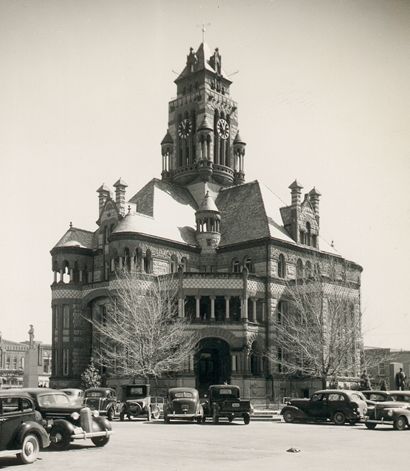
Ellis County Courthouse as it apppeared in 1939
Photo courtesy TXDoT
Today, remnants of late 19th Century Waxahachie prosperity are apparent all around town. The large number of late Nineteenth Century Victorian-style homes and buildings remaining today has given Waxahachie the title of "The Gingerbread City". In fact, the town of Waxahachie has about 20% of all the buildings listed in the National Register of Historic Places in Texas.
The vintage Victorian-style homes combined with a picture perfect courthouse square has made the perfect backdrop for several Hollywood movies. Film footage for the 1967 classic "Bonnie and Clyde" and the Academy Award winning "Tender Mercies" were both shot on location here.
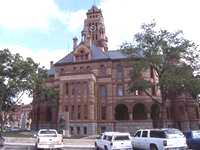 |
Ellis County Courthouse October 2002 Copyright Sam Fenstermacher |
|---|
The Ellis County Courthouse
The Ellis County Courthouse was built from architectural plans created by J. Riely Gordon. The building incorporates the Richardsonian Romanesque architectural style originally created by Boston architect Henry Hobson Richardson and made popular in Texas by J. Riely Gordon.
For the Ellis County Courthouse Gordon used a floor-plan different from many other county courthouses in Texas of the same vintage. Many county courthouses built in this time period had intersecting halls on the first floor that created the rigidity required to support the weight of the district courtroom positioned near the middle of the building on the second floor. For the Ellis County Courthouse Gordon used a floor plan that provided an open space at the center of the building first surrounded by a staircase then surrounded by a gallery that provided access to offices and courtrooms. The large second-floor courtroom was pushed off to one side of the building so the center space was open all the way up to the clock tower. This open space at the center of the courthouse created a chimney effect. Cool air was drawn in through first floor windows toward the center of the building then straight up to the tower where hot air was exhausted out of the building.
Besides the advantage of superior ventilation, Gordon's design incorporated a circular form which worked well with the Romanesque Revival architectural style. Turrets containing spiral stairways and balconies incorporate readily with the circular form. The building is further enhanced by the use of stone of contrasting colors. From the building's base first gray and then pink granite are used. Red Pecos sandstone is used for accent, and cream colored sandstone is also used sparingly on a few stringcourses.
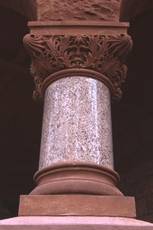 |
Column made of polished pink granite with red sandstone capital and base. Note face carved in column capital. October 2002 Copyright Sam Fenstermacher |
|---|
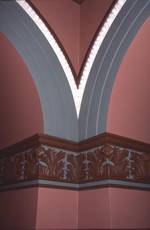 |
An image illustrating the fine detail of the interior restoration of the Ellis County Courthouse. October 2002 Copyright Sam Fenstermacher |
|---|
Ellis County's courthouse is without a doubt one of the grandest old county courthouses in the Southwest. To make it even more interesting the county recently spent about eleven million dollars restoring the building. After years of restoration work, the courthouse was reopened in the fall of 2002. The restoration was so detailed that they matched the colors of the interior to those used when the building was originally built, and the county bought red sandstone for repairs from the same query that produced the stone used for construction in 1895. This is truly a good time to go see the Ellis County Courthouse!
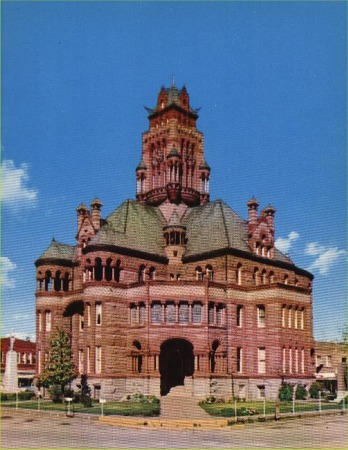
Ellis County Courthouse
Postcard courtesy www.rootsweb.com/ %7Etxpstcrd/
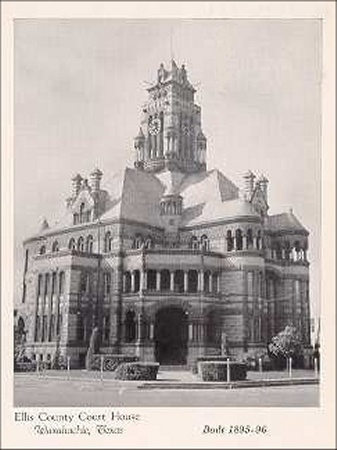
Postcard courtesy www.rootsweb.com/ %7Etxpstcrd/
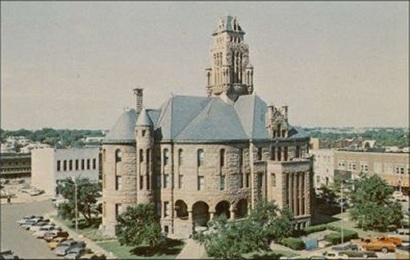
Postcard courtesy www.rootsweb.com/ %7Etxpstcrd/
Bibliography:
Texas Historical Commission, Texas Historic Sites Atlas.
http://atlas.thc.state.tx.us/, 2003.
"WAXAHACHIE, TX." The Handbook of Texas Online. http://www.tsha.utexas.edu/handbook/online/articles/view/WW/hew2.html, 2003.
Copyright � 2003 by Sam Fenstermacher All rights reserved
People
Richard Ellis
by Mike Cox ("Texas Tales" Column)
His imagined likeness stands frozen in bronze outside the courthouse of the county bearing his name, but Richard Ellis is a long way from being one of the more-recognized figures in Texas history....
